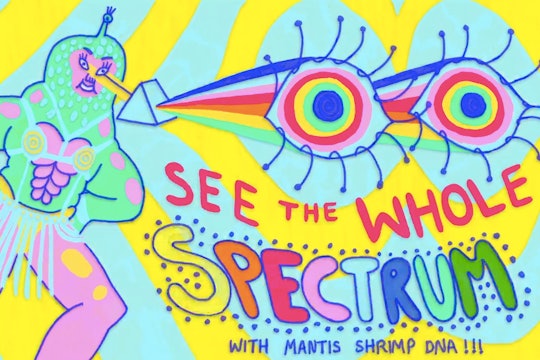

Produced in partnership with ASU Center for Science and the Imagination
We still don't know all the consequences of gene manipulation
Genome meddling to cure diseases is often worth the risk, but nothing else is just yet
At a recent event with evolutionary biologist Richard Dawkins, science writer Carl Zimmer posed the following question: “There is a gene variant in some Icelanders that protects them against Alzheimer’s disease. Do you think it is ethical to give this gene to others to keep Alzheimer’s at bay?”
“By all means," Dawkins replied. "There is nothing wrong with improving lives.”
I definitely agree with Dawkins. However, I'd add: as long as the potential benefits outweigh the risk. And with our current understanding of human physiology and genetics, that is definitely not the case.
Human beings have always yearned to better themselves – to rise beyond nature’s lottery. We are so immersed in our modern enhancements that we are often oblivious to them. LASIK surgeries (or glasses, for that matter!), cochlear implants, plastic surgeries, and birth-control pills are all examples of things we do to overcome what we perceive as our natural limitations. But what gets people really wound up is the idea of genetic enhancement – improving traits by changing the genes inside of us.
We can define genetic enhancement as the manipulation of one’s genome to modify a non-pathological feature. So if I take a gene or a set of genes known to make Usain Bolt the fastest man alive and add them to myself, I am genetically enhancing myself. However, in reality, enhancements are much more complicated than just replacing a few genes.
Gene therapy for genetic disorders – at least, those that result from a single genetic mutation – has come a long way in the past three decades. In 2017, we witnessed several milestones, including the treatment of hemophilia and of Spinal Muscular Atrophy. But gene therapy is still complicated, with severe side effects and unforeseen consequences. For example, in early 2000s, successful gene therapy for Severe Combined Immunodeficiency was overshadowed by the development of cancer in two patients. I'd argue that for deleterious mutations, the risks are justified by the promise of treating a disease. But for enhancements, we are nowhere close to a clear justification. We know of many genetic changes that in theory should create "superhuman" traits in people, but they come with debilitating consequences.
Imagine changing a single gene so that you no longer feel pain. There are people with mutations that result in not feeling pain, a condition known as congenital analgesia. Not only is this not a superpower, but people with congenital analgesia cannot live normal lives. They burn their hands on stoves without realizing, or have severe organ malfunction without feeling any pain.
Or imagine having bones that are several times denser than the average human’s, bones so dense you could get hit by a car and walk away unscathed. In reality, people with mutations that result in unbreakable bones suffer from a condition known as Sclerosteosis. Their bones can be so dense that their brains crush under the force of their own skull. One cannot help but wonder about other genetic changes that may appear to add to our human powers, but are just terrible diseases in reality. The bottom line is that we do not know all the outcomes of creating a single mutation in an individual, and chances are we will not know enough anytime soon.
Even if a mutation appears to have beneficial effects on the individual, we do not know all the potential side effects in the near and far future. Every now and then, based on our studies on model organisms, we come across single genes with dramatic effects on a single trait. In 1999, researchers expressed a protein that binds hippocampal receptors in the brains of mice in an attempt to improve their cognitive ability. The mice showed remarkable memory and cognitive performance, which led to the researchers naming the mice Doogie, after the genius television character Doogie Howser.
Almost 20 years later, we now know about 35 mutations in mice that improve learning and memory. We still do not know a lot about the downside to these mice, but several strains raise alarming concerns: many of the mutations that increase cognitive ability may have detrimental effects. The Doogie mice described above may be intelligent, but they have an increased sensitivity to pain. As another example, the Hras strain of mice, may excel at solving puzzles, but they have a heightened fear response. Other strains with phenomenal intelligence at complicated tasks like solving puzzles fail at simple ones like remembering where they hid their food.
The challenges are amplified when we consider that most traits are the results of tens, hundreds, or even thousands of genes, interacting in different organs. You may want to get taller, but there are about 200 genes that play a role in determining your height in your early development. Another problem is that we only move in one direction in time: we get old. Even if you could go in all your cells and change every single one of those height-altering genes for the tallest versions possible, your body is no longer in the developmental stage for those changes to manifest themselves. You can't become super tall or super fast if you already developed with your own average genes interacting in your body.
This takes us to a whole new level of augmentation: embryo editing. Gene editing on a single-cell embryo means that the change will be passed on to the next generation(s). However, embryo editing is still in its infancy. Even the most outstanding breakthrough in embryo editing, published last year, was met with outrage and disbelief by the scientific community; a group of prominent scientists challenged the basic tenets of the paper, arguing that editing in embryos was not achieved as seamlessly as the authors had suggested.
Overall, we are nowhere close to being able to safely edit the genomes of embryos or adults. So before we start trying to turn ourselves into Usain Bolt, let's learn more about how our genes make us who we are.
